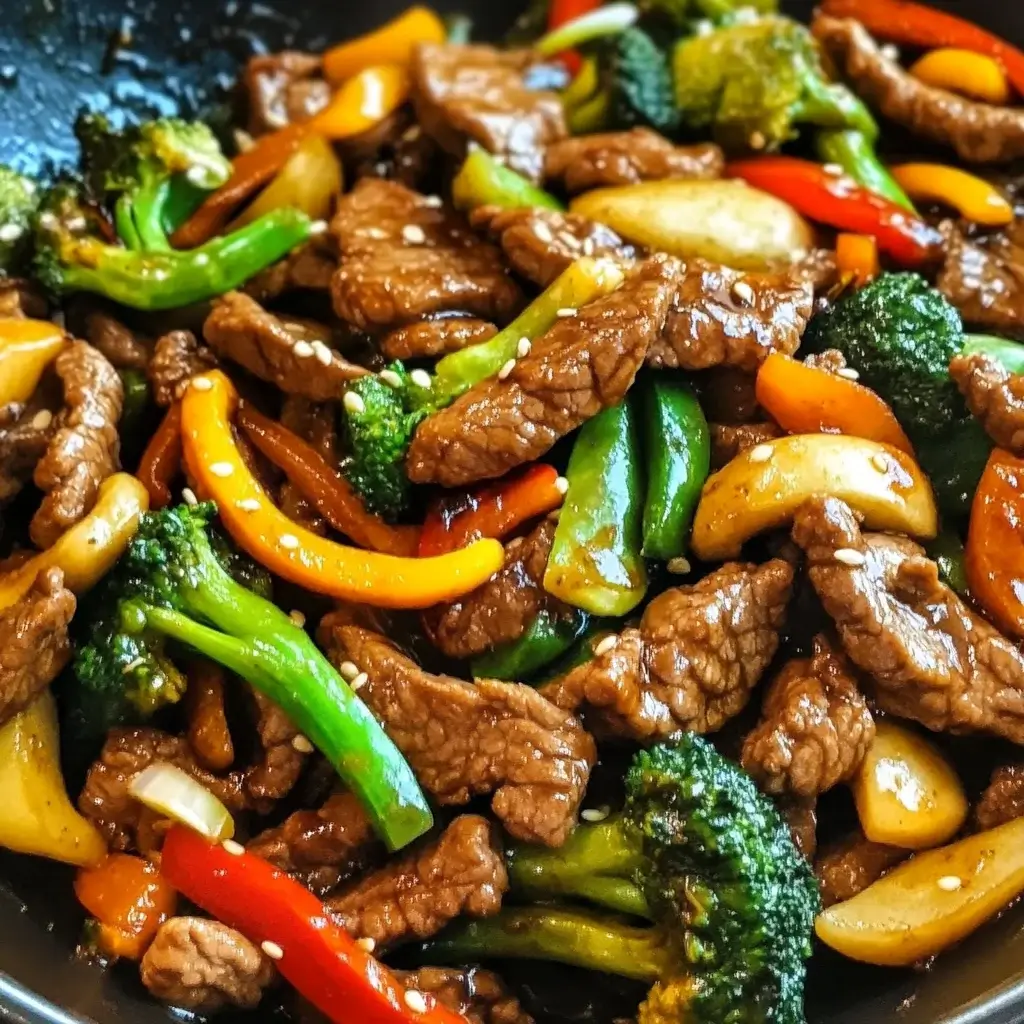After a long, blustery Easter egg hunt in the garden, there’s nothing my family craves more than a warm, satisfying meal that’s packed with flavour and goodness. This Easter Veggie Beef Stir Fry has become our absolute go-to. It’s vibrant, bursting with the fresh tastes of spring vegetables, and the tender beef is incredibly comforting. Even my picky eaters, who usually turn their noses up at anything green, devour this dish! The combination of sweet bell peppers, crisp asparagus, and tender carrots, all coated in a savoury stir-fry sauce, is simply irresistible. It’s quick to whip up, making it perfect for a busy Easter weekend, and it’s a wonderful way to use up any leftover Easter veggies you might have on hand. Trust me, this stir fry is a winner – it’s become an Easter tradition in our home, and I’m sure it will become one in yours too!
Ingredients
- 1 pound beef sirloin or flank steak: Thinly sliced against the grain for maximum tenderness and quick cooking.
- 1 tablespoon olive oil: Used for searing the beef and stir-frying the vegetables, adding healthy fats and flavour.
- 1 red bell pepper: Cored, seeded, and sliced into strips, providing sweetness and vibrant colour.
- 1 yellow bell pepper: Cored, seeded, and sliced into strips, adding another layer of sweetness and visual appeal.
- 1 green bell pepper: Cored, seeded, and sliced into strips, offering a slightly more savoury note and balanced flavour.
- 1 bunch asparagus: Trimmed and cut into 1-inch pieces, bringing a delicate spring flavour and vibrant green colour.
- 1 cup baby carrots: Halved or quartered lengthwise, adding sweetness and a satisfying crunch.
- 1 cup snow peas: Trimmed, providing a delicate sweetness and crisp texture.
- 1/2 cup broccoli florets: Cut into small, bite-sized pieces, adding a hearty texture and earthy flavour.
- 1/2 cup chopped onion: Yellow or white onion, adding a foundational savoury flavour to the stir fry.
- 2 cloves garlic: Minced, providing a pungent and aromatic flavour boost.
- 1 inch ginger: Fresh ginger, peeled and minced, adding a warm, spicy, and slightly sweet flavour.
- 1/4 cup soy sauce: Low-sodium soy sauce recommended, providing a salty and umami base to the stir-fry sauce.
- 2 tablespoons honey: Adds sweetness and balances the saltiness of the soy sauce, creating a delicious glaze.
- 1 tablespoon rice vinegar: Adds acidity and brightness, balancing the sweetness and saltiness and enhancing the overall flavour profile.
- 1 tablespoon cornstarch: Used as a thickening agent for the stir-fry sauce, creating a glossy and clinging texture.
- 1 tablespoon sesame oil: Added at the end for aroma and flavour, lending a nutty and distinctive Asian touch.
- Salt and black pepper: To taste, for seasoning and enhancing the overall flavours of the dish.
- Optional garnishes: Sesame seeds, chopped green onions, red pepper flakes, for added flavour, texture, and visual appeal.
Instructions
- Prepare the Beef: Begin by thinly slicing the beef sirloin or flank steak against the grain. This is crucial for ensuring tenderness, as it shortens the muscle fibers. Place the sliced beef in a bowl. You can optionally marinate the beef for about 15-20 minutes to enhance its flavour and tenderness. A simple marinade could consist of 1 tablespoon of soy sauce, 1 teaspoon of cornstarch, and a dash of black pepper. This step, while optional, can significantly elevate the final dish, especially if you are using a less tender cut of beef.
- Prepare the Vegetables: While the beef is marinating (or immediately if you’re skipping the marinade), prepare all your vegetables. Wash and dry the bell peppers, then core them, remove the seeds, and slice them into strips. Trim the asparagus and cut it into 1-inch pieces. Halve or quarter the baby carrots lengthwise. Trim the snow peas. Cut the broccoli florets into small, bite-sized pieces. Chop the onion and mince the garlic and ginger. Having all your vegetables prepped and ready to go is essential for stir-frying, as the cooking process is quick, and you’ll need to add ingredients in rapid succession.
- Make the Stir-Fry Sauce: In a small bowl, whisk together the soy sauce, honey, rice vinegar, cornstarch, and sesame oil. Ensure the cornstarch is fully dissolved to prevent lumps in the sauce. This sauce is the heart of the stir fry, providing the characteristic savoury, sweet, and tangy flavour profile. Taste and adjust the sauce to your preference – you might want to add a touch more honey for sweetness or rice vinegar for tanginess. Set the sauce aside for now.
- Sear the Beef: Heat the olive oil in a large wok or skillet over high heat. Make sure the wok or skillet is very hot before adding the beef; this is crucial for searing the beef properly and achieving a nice browning. Add the sliced beef in a single layer, being careful not to overcrowd the pan. Work in batches if necessary to ensure proper searing. Sear the beef for about 1-2 minutes per side, or until it is nicely browned but still slightly pink in the center. Remove the seared beef from the wok and set it aside. Do not overcook the beef at this stage, as it will continue to cook later when added back to the stir fry.
- Stir-Fry the Aromatics: In the same wok or skillet, add the chopped onion and stir-fry for about 1-2 minutes until it becomes fragrant and slightly softened. Then, add the minced garlic and ginger and stir-fry for another 30 seconds until fragrant. Be careful not to burn the garlic and ginger, as this can make them bitter. The aromatics form the flavour base of the stir fry, so sautéing them properly is important.
- Add the Heartier Vegetables: Add the bell pepper strips and carrots to the wok. Stir-fry for about 3-4 minutes until they are slightly tender-crisp. The goal is to cook them until they are just tender but still retain some of their crunch. Stir frequently to ensure even cooking and prevent burning.
- Add the Tender Vegetables: Add the asparagus and broccoli florets to the wok. Continue to stir-fry for another 2-3 minutes until they are bright green and tender-crisp. Again, maintain a high heat and stir frequently.
- Add the Snow Peas and Beef: Add the snow peas and the seared beef back to the wok. Stir-fry for another 1-2 minutes until the snow peas are bright green and the beef is heated through.
- Pour in the Sauce and Thicken: Pour the prepared stir-fry sauce over the vegetables and beef in the wok. Stir everything together to coat evenly. Cook for another 1-2 minutes, stirring constantly, until the sauce thickens and becomes glossy. The cornstarch in the sauce will activate with the heat and create a beautiful, clinging glaze.
- Season and Serve: Taste the stir fry and season with salt and black pepper to taste. Remember that soy sauce is already salty, so taste before adding additional salt. Remove from heat and serve immediately over rice, noodles, or quinoa. Garnish with sesame seeds, chopped green onions, or red pepper flakes if desired. Enjoy your delicious Easter Veggie Beef Stir Fry!
Nutrition Facts
(Per Serving, approximate values, based on 4 servings – Note: Nutritional values can vary based on specific ingredients and portion sizes.)
- Calories: Approximately 450-550 kcal: Provides a substantial amount of energy, making it a satisfying and filling meal. This calorie range is suitable for a main course.
- Protein: 30-40 grams: High in protein from the beef, essential for muscle building and repair, and promoting satiety. Protein contributes to feeling full and satisfied after the meal.
- Fat: 20-30 grams: Includes healthy fats from olive oil and sesame oil, as well as fats from the beef. Fats are important for nutrient absorption and hormone production. The type of beef cut and the amount of oil used will affect the fat content.
Preparation Time
- Prep Time: 20-25 minutes: This includes slicing the beef, chopping all the vegetables, mincing garlic and ginger, and whisking together the stir-fry sauce. Efficient preparation beforehand makes the cooking process much faster and smoother.
- Cook Time: 15-20 minutes: This involves searing the beef and stir-frying the vegetables and sauce. Stir-frying is a quick cooking method, ensuring vegetables remain crisp and nutritious.
- Total Time: 35-45 minutes: From start to finish, this Easter Veggie Beef Stir Fry is a relatively quick meal to prepare, perfect for busy weeknights or Easter weekend gatherings when time might be limited.
How to Serve
This Easter Veggie Beef Stir Fry is incredibly versatile and can be served in many delicious ways:
- Over Rice:
- White Rice: A classic and simple choice, allowing the flavours of the stir fry to shine. Provides a neutral base to soak up the delicious sauce.
- Brown Rice: A healthier option, offering more fiber and a nutty flavour. Adds texture and nutritional value.
- Jasmine Rice: Fragrant and slightly sticky, complementing the Asian-inspired flavours of the stir fry. Enhances the aromatic experience of the meal.
- With Noodles:
- Egg Noodles: Soft and chewy, they pair well with the saucy stir fry and are a classic stir-fry accompaniment.
- Udon Noodles: Thick and chewy Japanese noodles, providing a substantial and satisfying base. Their texture holds up well to the stir-fry sauce.
- Rice Noodles: Gluten-free option, light and delicate, absorbing the flavours of the sauce beautifully. A lighter alternative to egg or udon noodles.
- Grain Bowls:
- Quinoa: A protein-rich and gluten-free grain, adding nutritional value and a slightly nutty flavour. Provides a healthy and wholesome base.
- Farro: Chewy and nutty grain, offering a hearty and wholesome base with a pleasant texture. Adds a different flavour profile compared to rice or quinoa.
- As Lettuce Wraps:
- Crisp Lettuce Cups (like butter lettuce or romaine): A low-carb and refreshing way to serve the stir fry. Provides a cool and crisp contrast to the warm stir fry.
- Garnish Options:
- Sesame Seeds: Toasted sesame seeds add a nutty flavour and a pleasant crunch. Enhances the visual appeal and adds a layer of flavour.
- Chopped Green Onions: Fresh green onions provide a mild oniony flavour and vibrant green colour. Adds freshness and a pop of colour.
- Red Pepper Flakes: For those who like a bit of heat, red pepper flakes add a spicy kick. Allows for customization of spice level.
- Fresh Cilantro: Adds a fresh, herbaceous note, especially if you enjoy cilantro’s flavour. Provides a different flavour dimension.
- Lime Wedges: A squeeze of fresh lime juice brightens up the flavours and adds a touch of acidity. Balances the richness of the stir fry.
Additional Tips for the Perfect Easter Veggie Beef Stir Fry
- Choose the Right Cut of Beef: For a stir fry, tender cuts of beef like sirloin, flank steak, or ribeye are ideal. These cuts cook quickly at high heat and remain tender. If using a less tender cut, marinating it for a longer period can help improve its texture. Slice the beef thinly against the grain for maximum tenderness.
- Prep Everything in Advance (Mise en Place): Stir-frying is a fast-paced cooking method. Having all your ingredients prepped and ready to go – beef sliced, vegetables chopped, sauce whisked – will make the cooking process much smoother and more efficient. This ensures you can add ingredients quickly and at the right time, preventing overcooking or burning.
- High Heat is Key: Stir-frying requires high heat to quickly cook the ingredients while maintaining their texture and flavour. Ensure your wok or skillet is properly heated before adding the beef and vegetables. The high heat sears the beef and vegetables, creating a desirable slightly charred flavour and preventing them from becoming soggy.
- Don’t Overcrowd the Pan: Overcrowding the wok or skillet will lower the temperature and steam the ingredients instead of stir-frying them. Cook the beef and vegetables in batches if necessary to maintain high heat and ensure proper browning and crispness. Working in smaller batches allows for better heat circulation and even cooking.
- Tender-Crisp Vegetables are Ideal: The vegetables in a stir fry should be tender-crisp, meaning they are cooked through but still retain a slight crunch. Avoid overcooking them, as they will become mushy and lose their flavour and nutritional value. Add vegetables in order of their cooking time, starting with harder vegetables like carrots and broccoli, and ending with quicker-cooking vegetables like snow peas and asparagus.
- Adjust the Sauce to Your Taste: The stir-fry sauce is easily customizable. Adjust the amount of honey for sweetness, rice vinegar for tanginess, or soy sauce for saltiness to suit your preferences. You can also add other flavour enhancers like oyster sauce, hoisin sauce, or chili garlic sauce for a different flavour profile. Taste the sauce before adding it to the stir fry and make any necessary adjustments.
- Don’t Forget the Aromatics: Garlic and ginger are essential aromatics in stir fries, adding depth of flavour and complexity. Sauté them briefly in oil before adding the vegetables to release their fragrance and infuse the oil with their flavour. Freshly minced garlic and ginger are always best for the most potent flavour.
- Garnish for Flavour and Visual Appeal: Garnishes like sesame seeds, chopped green onions, and red pepper flakes not only add flavour and texture but also enhance the visual appeal of the dish. Garnishes can elevate the presentation of the stir fry and add a finishing touch of flavour and freshness. Experiment with different garnishes to find your favourites.
FAQ about Easter Veggie Beef Stir Fry
Q1: Can I use different vegetables in this stir fry?
A: Absolutely! One of the best things about stir fries is their versatility. Feel free to substitute or add other spring vegetables like snap peas, green beans, baby spinach, or even sliced mushrooms. You can also use frozen vegetables, just make sure to thaw and drain them properly before stir-frying. Get creative and use whatever vegetables you have on hand or prefer.
Q2: Can I make this stir fry vegetarian or vegan?
A: Yes, easily! To make it vegetarian, simply omit the beef and add firm tofu or tempeh, cubed and pan-fried or stir-fried until golden brown. For a vegan version, ensure your soy sauce and any other sauce components are vegan-friendly (some soy sauces may contain honey). You can increase the amount and variety of vegetables to make it a hearty and satisfying vegetarian or vegan meal.
Q3: Can I prepare this stir fry ahead of time?
A: It’s best to enjoy stir fry fresh for optimal texture and flavour, especially for the vegetables which are meant to be tender-crisp. However, you can prepare the beef and vegetables separately ahead of time and store them in the refrigerator. You can also make the sauce ahead of time and store it separately. When ready to serve, quickly stir-fry the vegetables and beef together and add the sauce to heat through and thicken.
Q4: How do I store leftover stir fry?
A: Store leftover stir fry in an airtight container in the refrigerator for up to 3-4 days. Reheat it in a wok or skillet over medium heat until heated through. You can add a splash of water or broth if it seems dry during reheating. Keep in mind that the vegetables may soften slightly upon reheating.
Q5: Can I use a different type of protein instead of beef?
A: Yes, you can easily substitute beef with other proteins. Chicken breast or thighs, shrimp, pork tenderloin, or even lamb would work well in this stir fry. Adjust the cooking time accordingly based on the protein you choose. Make sure to cook the protein thoroughly to ensure food safety.
Q6: Is this stir fry gluten-free?
A: As written, this recipe is not gluten-free due to the soy sauce, which typically contains wheat. To make it gluten-free, use tamari or coconut aminos instead of soy sauce. Also, ensure that any other sauce ingredients you use are gluten-free. Cornstarch is generally gluten-free, but always check the label to be certain if you have severe gluten sensitivities.
Q7: Can I make this stir fry spicier?
A: Absolutely! To add some heat, you can include red pepper flakes in the stir fry sauce or add a dash of chili garlic sauce or sriracha. You can also add sliced fresh chili peppers like jalapeños or Thai chilies while stir-frying the vegetables. Adjust the amount of spice to your preference.
Q8: What if I don’t have rice vinegar? Can I use another type of vinegar?
A: If you don’t have rice vinegar, you can substitute it with white wine vinegar or apple cider vinegar. These alternatives will provide a similar level of acidity. In a pinch, you could even use lemon juice or lime juice, though they will impart a slightly different flavour profile. Rice vinegar is preferred for its mild and slightly sweet flavour, which complements Asian-style dishes well.






